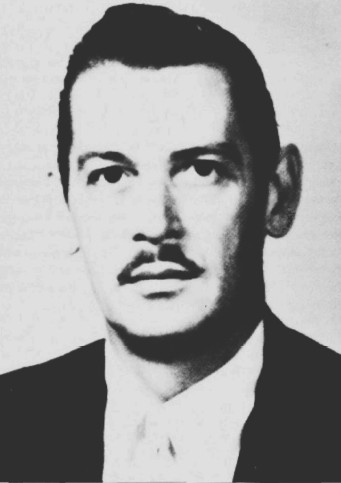
Munro S. Edmonson in 1968
Munro S. Edmonson (1924-2002)
played the role of the "Anthropology Major" in the 1951
performances, and of the "Professor" in the 1952 performance.
At the time of the first two shows, he was a graduate student in social
anthropology. At one point during his time at Harvard, he was Tom
Lehrer's roommate. Shortly after those two shows in January 1951,
he started teaching at Washington University in St. Louis, while finishing
his Ph.D. dissertation. It appears that the timing of the third show
(in May 1952) allowed him to participate easily, since he would have
come back for his official graduation ceremony then.
Trivia from Tom Lehrer: "I spoke no Russian (and still speak none), and it was Munro Edmonson who taught me (phonetically) the Russian phrase I used in 'Lobachevsky' regarding going where even the Tsar goes on foot"*
It's clear from Edmonson's participation in the "Physical Revue" that he had a good sense of humor, and in fact humor formed the basis of some of his scholarly work. His Harvard Ph.D. thesis (1952) is titled "Los Manitos: Patterns of Humor in Relation to Cultural Values", and even up through his last paper (written in 1987) he continued work in this area, as shown by the paper "Notes on Laughter" [Anthropological Linguistics 29(1): 23-34] He grew up with "a family tradition of singing, particularly of the corridos of northern Mexico, which readily leant themselves to brotherly harmonizing".1
Known as "Ed" to his friends at Harvard and later Tulane, he was a master of many languages. He grew up in Nogales, Arizona, and was bilingual in English and Spanish. "In order to qualify for admission to Harvard, he had to learn Latin and Greek, which were not taught in Nogales schools. He was tutored in Latin by a neighbor and in Greek by a local photographer of Greek descent."2 While at Harvard, he studied French, German, and Russian!
His undergraduate major was in sociology, and he graduated in 1944 after three years, as part of a "wartime accelerated program".1 He immediately went into the navy, and served on the destroyer USS Purdy in the Pacific theatre, rising to the rank of Lieutenant, J.G. He returned to Harvard for graduate studies in social anthropology, and received his Ph.D. in 1952. In the fall of 1951, he joined the faculty of Tulane University, first as part of the newly established interdisciplinary Urban Life Research Institute, and eventually as a professor in the Department of Anthropology (once it was created), becoming its second chair in 1969. He continued at Tulane until his retirement in 1994.
In the 50s, he "became New Orleans's resident expert on Carnival and its relationship to the sociology of the city, and scarcely a year went by when he was not interviewed by the local newspaper in the days leading up to Mardi Gras, enlightening the citizens about the social significance of their activities."2 His early research interests also included race relations; in addition to publishing a book3 in this area, he was also active in efforts to desegregate New Orleans and Louisiana. After forays into a few other research areas, he returned to his love of languages. He tackled the language of the Quiche Maya of Guatemala, publishing first a dictionary (1965), then a grammar (1968), and finally a translation of the Popul Vuh, their literary masterpiece. Next, he turned to the language of the Maya of the Yucatan peninsula, first producing a dictionary, then translating their two most important books. One of his most important contributions came late in his career, when he used astronomy and a diffusion model to demystify Mayan and other Mesoamerican calendars, publishing a book4 in 1988. In retirement, he continued his interest in languages, this time Chinese, compiling his own dictionary.
He was president of the American
Ethnological Society in 1966, and authored, edited, or translated
at least ten books. (Click here
to see a listing of his books available from Amazon.com.)
Return to main page for "The Physical Revue"
Suggest more or better links .. Return to PhysicsSongs.org main page
Background image: Covers for Tom Lehrer's albums
References:
*Lehrer continues, "I've used various Russian expressions on
the various recordings. On the first (the 1953 10-inch), the first
phrase was the first line of Mussorgsky's Song of the Flea, with which
I was already familiar and which Ed taught me how to pronounce. It
means 'once there was a king who had a pet flea.' The second says
'now I go [or I must go] where even the Tsar goes on foot.' A reference,
of course, to the bathroom. As I said, Ed knew this expression and
passed it on to me when I was looking for a Russian phrase. In later
recordings I used, instead of the flea reference, a line from 'Meadowlands,'
a Russian song well known in the 40s, popularized by the Red Army
Chorus. It means something like 'hail the mighty Red Army.' "
1 - "Munro Edmonson, a Life in Anthropology", by B. W. Edmonson,
Human Mosaic 28(2), 7-20 (1995).
2 - "Munro Sterling Edmonson (1924-2002)", by V. R. Bricker,
American Anthropologist 105(3), 682-4 (2003).
3 - The Eighth Generation: Cultures and Personalities of New Orleans
Negroes (Rohrer and Edmonson 1960)
4 - The Book of the Year: Middle American Calendrical Systems.
Salt Lake City: University of Utah Press, 1988.